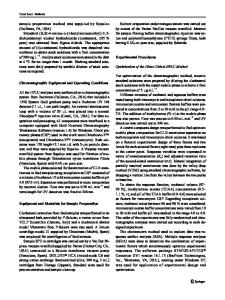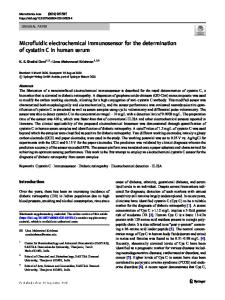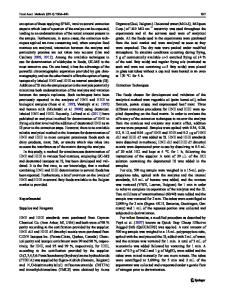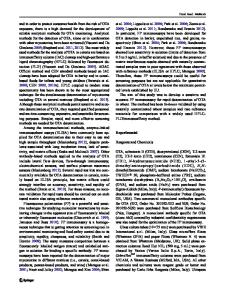Development of a Disposable Label-Free Impedance Immunosensor for Direct and Sensitive Clenbuterol Determination in Pork
- PDF / 571,371 Bytes
- 8 Pages / 595.276 x 790.866 pts Page_size
- 87 Downloads / 255 Views
Development of a Disposable Label-Free Impedance Immunosensor for Direct and Sensitive Clenbuterol Determination in Pork Linhong Wei 1,2 & Lin Liu 1 & Huiming Kang 1 & Shuzhao Liu 3 & Guoxiu Wang 4 & Xiaoya Hu 1 & Chengyin Wang 1
Received: 6 July 2015 / Accepted: 10 November 2015 / Published online: 18 November 2015 # Springer Science+Business Media New York 2015
Abstract In this work, a portable label-free impedance immunosensor for the analysis of clenbuterol (CLB) was constructed by modifying L-cysteine (L-cys) and glutaraldehyde (GA) on the surface of a screen-printed gold electrode (SPGE). Electrochemical impedance spectroscopy (EIS) and cyclic voltammetry (CV) were used to characterize electrochemical properties of the immunosensor. Under the optimized conditions, the immunosensor could detect CLB in the range of 1.0×10−4–1.0 mg/L (R=0.998), and the detection limit is 2.0×10−5 mg/L. The as-developed immunosensor can be applied in detecting CLB in real samples. The average recoveries in the spiked pork samples ranged from 92.4 to 104.6 %, and their relative standard deviations were 3.6– 5.2 %. The testing results were consistent with those obtained from high-performance liquid chromatography method. The proposed immunosensor exhibits high sensitivity, specificity, and good stability.
* Chengyin Wang [email protected] 1
College of Chemistry and Chemical Engineering, Jiangsu Key Laboratory of Environmental Engineering and Monitoring, Yangzhou University, 180 Si-Wang-Ting Road, Yangzhou 225002, China
2
College of Biological and Chemical Engineering, Yangzhou Vocational University, 458 Wen-Chang-Xi Road, Yangzhou 225009, China
3
College of Environmental Science & Engineering, Yangzhou University, 196 Hua-Yang-Xi Road, Yangzhou 225002, China
4
Department of Chemistry and Forensic Science, University of Technology Sydney, City Campus, Broadway, Sydney NSW 2007, Australia
Keywords Immunosensor . Clenbuterol . Electrochemical impedance spectroscopy . Screen-printed electrode
Introduction As a kind of β2-adrenoceptor agonist, clenbuterol (CLB) is widely used to treat diseases such as chronic obstructive pulmonary disease and bronchial asthma due to its function on the relaxation of tracheal smooth muscle (López-Erroz et al. 2000). CLB has been frequently reported to be abused as a Blean meat agent^ in breeding food-producing animals since some studies have revealed that it could promote muscle growth and inhibit fat synthesis, thus improving the ratio of lean meat and fat (Gianfranco et al. 2000). However, CLB is very difficult to be degraded in livestock bodies. Moreover, people having food containing CLB will suffer from some risks such as headache, dizziness, vomiting, palpitation or nervousness, muscle tremors and confusion, and even death (Zhou et al. 2007). Most countries or areas including the USA, the European Union, and China have legally prohibited CLB in breeding livestock and poultry (Li et al. 2012). Therefore, it is very important to detect residual CLB in livestock tissues for the sake of food
Data Loading...











